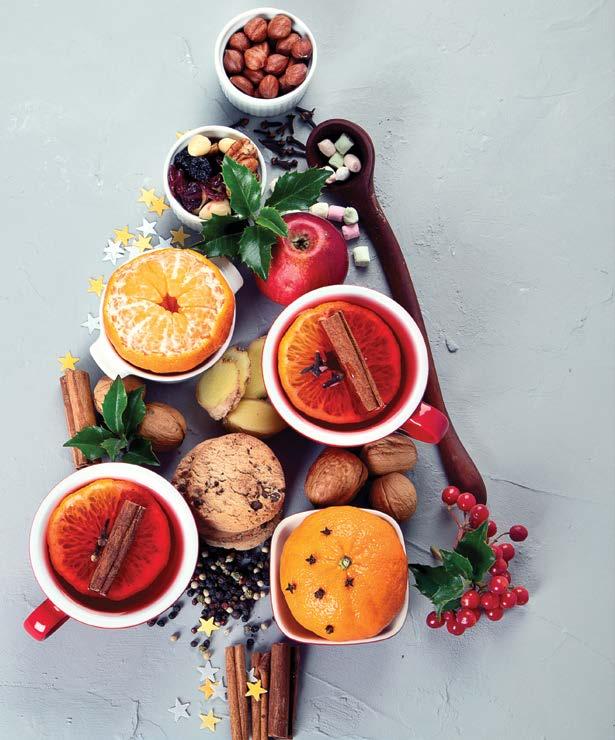
17 minute read
Festive food
FESTIVE DUCK SALAD
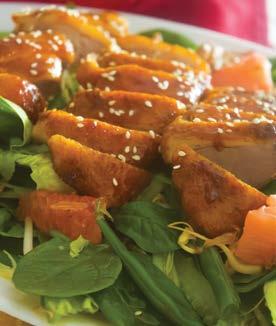
Advertisement
METHOD
Begin the day before. This is the very best of celebration dishes – you can make everything ahead of time, ready to assemble on the big day and best of all, it’s supremely adaptable. You can substitute the duck for chicken or use Marylands or a whole duck as you need to. As for the salad, everything is negotiable - buy the greens that is easiest on your budget rather than following this recipe to the letter.
INGREDIENTS
◆ 6 duck breasts OR 3 duck marylands, skin on (Or use a whole 2.2kg duck) ◆ 1 tbsp sea salt ◆ 2 garlic cloves, crushed ◆ zest of 1 ruby grapefruit ◆ 1 heaped tsp coriander seeds ◆ 2 tsp Chinese five-spice ◆ 1 tsp white pepper
Dressing:
◆ ¼ cup (60ml) hoisin sauce ◆ juice of ½ ruby grapefruit ◆ 1 tbsp honey ◆ 1 tsp sesame oil
Salad:
◆ 3 cups (150g) mixed salad leaves ◆ 250g (1½ cups) green beans (frozen beans are fine) ◆ ¼ cup roasted cashews ◆ 1 cup (70g) fresh bean sprouts ◆ 1 cup (50g) baby spinach leaves ◆ 4 spring onions, sliced on the diagonal ◆ ½ ruby grapefruit, pith removed and cut into segments ◆ 2 tbsp toasted sesame seeds
Serves 6 as part of a larger meal
1. Pat the flesh and skin of the duck dry with paper towels. Use a sharp knife to slash the skin of each breast three or four times. 2. Place the garlic, salt, zest, coriander seeds, five spice powder and pepper in a small food processor or a mortar and pestle and crush until you have a paste. Rub half the paste into the flesh and the other half all over the skin and deep into the cuts you have made. Place the breasts on a rack over a small baking tray and leave it to dry out on the bottom rack of the fridge, uncovered, overnight. 3. Preheat the oven to 170°C (fan-forced). Place the duck on a rack in a roasting tray skin-side down and roast for 35 minutes.
Flip the pieces over and prick the skins all over with a toothpick to help release as much fat as you can, then roast for a further 20 minutes. 4. While the duck is roasting, combine all the dressing ingredients in a small bowl and mix well. Set aside a quarter of the dressing for the salad (it stores well in a covered container for up to three days in the fridge). 5. Remove the duck from the oven and spoon off as much fat as you can from the bottom of the tray. Turn the oven heat up to 220°C (fan-forced). Brush the warm duck all over with the remaining dressing. Bake for a further 5 minutes until the duck is glossy and the skin is crisp. Allow the duck to cool to room temperature. At this point you can store it in a covered container for up to 48 hours until you are ready to serve. 6. To assemble: Rinse the salad leaves and pat dry. Trim the green beans and cook them in boiling water for 3 minutes, then plunge them into iced water to stop them cooking. 7. In a large bowl combine all the salad ingredients except the sesame seeds and toss well to combine. Arrange the salad on a large platter and spoon the reserved dressing over the top. Using a very sharp knife, slice the breasts (and marylands if using) into thick pieces. Arrange the duck over the salad leaves and scatter sesame seeds over the top. Serve at once.
Once made at the end of the day by Hong Kong fisherman from the crabs they could not sell, this magnificent meal is a worthy centrepiece to any celebratory feast. I’ve used blue swimmer crab here, but any uncooked crab will do, the meatier the better. Allow everyone to pick their way through the succulent crab pieces and have crab crackers or nut crackers and plenty of napkins for use for this is not a dish to eat with knife and fork. It’s messy and glorious and riotous. Isn’t that what a good celebration is about?
TYPHOON SHELTER CRAB
INGREDIENTS
◆ 2 bulbs garlic, cloves peeled and finely chopped ◆ ¼ cup rice bran or peanut oil ◆ 6 uncooked blue swimmer crabs, about 1.8-2kg in total ◆ ¼ cup cornflour ◆ ¾ cup rice bran or peanut oil, extra ◆ 12 shallots, peeled and finely sliced ◆ 2 tbsp finely grated ginger ◆ 4 birds-eye chillies, finely sliced ◆ 4 dried chillies, finely sliced ◆ ¼ cup light soy sauce ◆ ¼ cup black beans, finely chopped ◆ 6 spring onions, sliced thinly on the diagonal ◆ 100ml water ◆ 80ml Shaoxing (rice wine) ◆ Steamed rice to serve (optional)
Serves 6 as part of a larger meal
METHOD
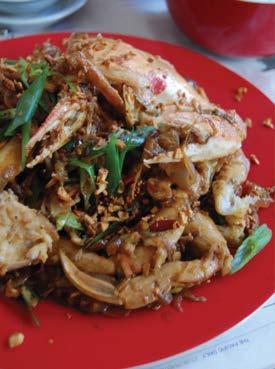
1. Finely chop the garlic and place in a small bowl and cover with cold water by 2cm.Soak for 10 minutes. Drain, then pat dry on paper towel. Heat a wok over high heat and add 3 tablespoons oil. Fry the garlic for 3 minutes until golden brown and crispy. Remove from the oil with a slotted spoon, drain the garlic on paper towel and set aside. 2. Prepare and clean the crabs. Turn the crab over and remove the hinged ‘apron’. Turn the crab over and remove the top shell and set the shell aside. Scoop out the stomach and remove mouth, eyes and gills, then pat dry. Use a large knife to cut the crab in half, then through each piece to remove each leg. Crack some of the larger pieces with the back of a large knife.
Dust the crab pieces in cornflour. Dust the reserved top shells in cornflour and set aside. 3. Heat the remaining oil over high heat in a wok. Fry the crab pieces and top shells, in batches, for 5 minutes until the shells are red and crab is just cooked through. Remove and set aside. 4. Add shallots, ginger and chillies to the wok and stir fry for one minute. Add soy and black beans and half the spring onions and stir fry for a further minute. 5. Return the crab to the wok, add water and cook for one minute. Add remaining spring onions, Shaoxing and half the crispy garlic to the wok and stir well to thoroughly coat the crab pieces. Remove from heat. 6. Spoon the crab pieces onto a large platter with the shells to decorate. Scatter remaining fried garlic over the top and serve with steamed rice, a favourite chilli sauce for bite and plenty of crab crackers and napkins.
FREEKEH SALAD WITH HONEY AND PEACH

This salad offers a wonderful contrast of textures and, if you are serving it as part of this feast, cuts across the richness of the duck or spice of the crab. It also pairs wonderfully with baked ham or roast turkey as part of a more traditional meal.
Freekeh is a green wheat-based grain, but if you want a gluten-free alternative, use brown rice. It can be cooked ahead of time then stored in an air-tight container in the fridge, ready to be used at the last minute.
INGREDIENTS
◆ 2 cups (300g) freekeh ◆ 750ml (3 cups) vegetable stock or water ◆ 2 large peaches ◆ 2 tsp olive oil ◆ 1 red onion, halved, thinly sliced ◆ 1 garlic clove, crushed ◆ ½ tsp ground cumin ◆ ¼ tsp ground cinnamon ◆ ¼ tsp ground turmeric ◆ 1 cup cherry tomatoes, halved or quartered ◆ ½ cup firmly packed coarsely chopped fresh parsley ◆ 120g baby spinach leaves, washed and drained.
Dressing:
◆ 2 tbsp lemon juice ◆ 2 tbsp warmed honey ◆ 1 tbsp seeded mustard ◆ sea salt and freshly ground black pepper
Serves 6
METHOD
1. Heat vegetable stock in a small saucepan until it comes to the boil and add the freekeh. Simmer for 15 minutes until just cooked. Drain and cool. 2. Heat up a small saucepan of water over a medium heat. Cut a small cross in the bottom of each peach and place in the barely simmering water for 1 minute. Remove the peaches and as soon as you can handle them without burning yourself, peel away the skin. Cut the peaches into quarters, discard pit, then cut the peach flesh into 2 cm chunks and set aside. 3. Heat oil in a frypan over medium heat and add onion and garlic. Sauté for 2 minutes until the onion softens but does not colour. Add cumin, cinnamon and turmeric and stir well to combine, then fry for a further minute. Remove from heat and set aside. 4. Toss the freekeh with peaches, onion mixture, tomato parsley and half the spinach leaves and mix well. Combine all the dressing ingredients in a jar, cover and shake until well combined. 5. To serve, pour dressing over peach and freekeh mixture and toss well to combine. Place on a platter lined with remaining spinach leaves and serve immediately.
INGREDIENTS
◆ 4 medium beetroot, about the size of a tennis ball ◆ 6 cloves garlic ◆ 2 sprigs thyme ◆ olive oil ◆ sea salt to taste ◆ 2 large Granny Smith or other crispy and sharp-tasting apples ◆ juice 1 large lemon ◆ 2 tbsp olive oil ◆ 1 bunch mint ◆ ½ cup toasted walnuts ◆ 1-2 large fresh burrata, drained
Dressing:
◆ 2 tbsp wholegrain mustard ◆ 1 tsp grated horseradish ◆ ¼ cup balsamic ◆ 2 tbsp olive oil ◆ good pinch sea salt
Makes 6
METHOD
BEETROOT CARPACCIO WITH APPLE, MINT AND BURRATA
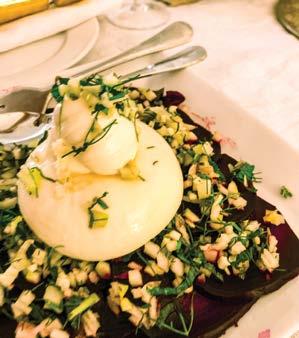
1. Scrub any dirt from the beetroots and trim the stalks to leave a 2cm stalk. If you want to reserve a few of the smaller beetroot leaves for a garnish, go ahead. 2. Preheat the oven to 190°C. Line a baking small roasting tray with a very large sheet of foil, enough that you can wrap back over the beetroots. Place the whole beetroots, the unpeeled garlic cloves and the scattered thyme leaves into the roasting dish. Drizzle with a little olive oil and a pinch of sea salt flakes and then wrap the whole thing up in the foil and crimp the edges to make a foil envelope. Bake for 45 minutes until a sharp knife can go through the centre of the beetroot easily. Set aside the roasted garlic cloves. 3. When they are cool enough to handle, put on some rubber gloves and peel the skins away from the beetroots. Slice the beetroots thinly and place in a large non-reactive bowl. 4. Dressing: Place all the ingredients into a large screw top jar. Squeeze out the flesh from the roasted garlic cloves into the dressing. Shake the jar until all the ingredients are combined and pour it over the warm beetroot. Toss briefly to combine and set aside. 5. Peel and core the apples, then cut them in half. Cut each half into 5mm slices and each slice into 5mm thick batons or dice.
Place in a bowl with the lemon juice and give them a quick toss to prevent them from discolouring. Add the olive oil, mint leaves and roughly chopped walnuts and toss briefly to combine. Check for seasoning - it may need a little salt to balance the acidity of the lemon. 6. To serve: Line a large platter with slices of beetroot. Scatter with apple and mint mixture. Place the drained burrata in the centre, then spoon any remaining dressing onto the apple.
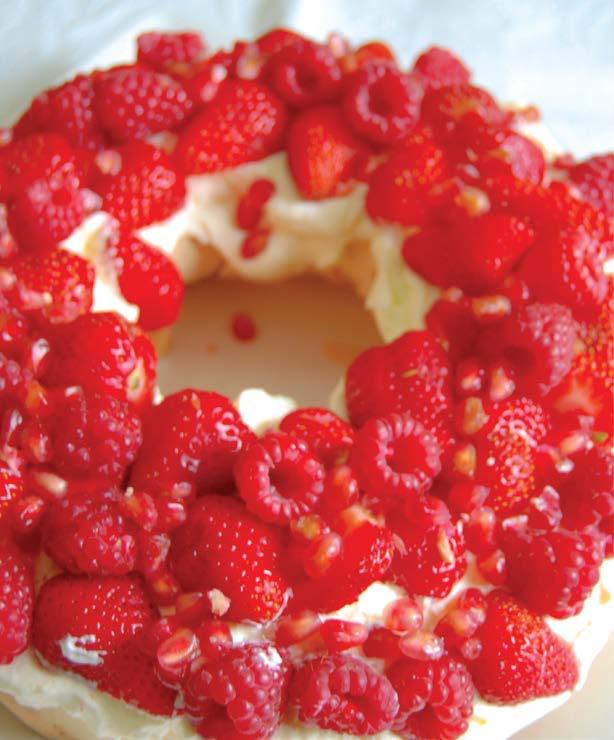
PAVLOVA WREATH
Yes, you want a non-traditional meal. But try and host a party without a pavlova as the central feature of a dessert spread and see how quickly someone notices. Face it: The pav is our national dessert. So, if you gently manipulate the pillowy meringue into a circle and then decorate it with festive touches, no one will think the worse of you.
Serves everyone at your table. (At least 8-10 people) INGREDIENTS
◆ 36 egg whites at room temperature ◆ 1 ¼ cups (270g) caster sugar ◆ 2 tsp cornflour ◆ 1 tsp white vinegar ◆ ½ tsp vanilla extract ◆ 300ml thickened cream ◆ 2 tbsp icing sugar mixture, sifted
Fruit topping:
◆ 2 punnets strawberries, 2 punnets fresh raspberries and the seeds of 1 pomegranate ◆ Juice ½ lime or 2 tablespoons marsala
METHOD
1. Preheat oven to 120°C. Line a large oven tray with baking paper. Spray with canola spray and dust with a tablespoon of cornflour, shaking off excess. Mark a 24cm diameter circle on the paper with the blade of a butter knife scored into the paper. If making a wreath, mark a smaller 12cm circle in the centre. 2. Using an electric mixer, whisk egg whites in a clean dry bowl until soft peaks form. Gradually add sugar, one tablespoon at a time, beating well after each addition, until meringue is thick and glossy and the sugar has dissolved.
There is no quick cheat’s way to do this, you need to beat each addition very thoroughly to enable the sugar to dissolve into the egg whites. The results will be a deliciously soft meringue that does not ‘weep’. This step could well take up to 20-25 minutes. Please, take your time. 3. Rub a little meringue between fingers. If you can still feel grains of sugar, continue to whisk until sugar dissolves.
Add cornflour, vinegar and vanilla and with the food mixer or your beaters set on low, very gently whisk until just combined. 4. Spoon meringue onto the baking sheet, using the marked circles as a guide. Now is not the time to reproduce a perfectly smooth-sided base - we’re going for a more artisanal look. Pile up the meringue towards the centre of the circle, smoothing the top but leaving the sides a swirling, undulating mass of meringue. 5. Bake in oven for 1½ hours or until pavlova is dry to the touch. Turn off oven and leave pavlova in oven to cool completely, overnight if possible. When completely cold, transfer to serving plate or store in an airtight container until required. 6. When ready to serve, use an electric mixer to whisk the cream and icing sugar in a medium bowl until firm peaks form. Spoon cream onto the top of pavlova. Wash and hull the berries and add them to a little lime juice or a dash of marsala and toss them gently. Drain. Decorate pavlova and serve at once.
COCONUT PANNA COTTA WITH POACHED CHERRIES
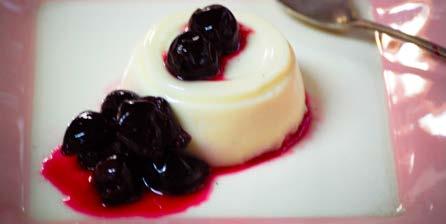
INGREDIENTS
◆ 320ml (1 and 1/3 cup) coconut cream ◆ 125ml (½ cup) pouring cream (substitute for coconut milk or plant-based cream) ◆ 110g (2/3 cup) caster sugar ◆ 3 leaves gelatine OR 1 tbsp gelatine powder
Poached Cherries:
◆ 250g fresh ripe cherries, pitted ◆ 110g (2/3 cup) caster sugar ◆ ½ tsp vanilla extract ◆ dash marsala (optional) Makes 6
Although this panna cotta has dairy in it, you can substitute the cream for coconut milk or a plant-based cream for a fully dairy-free dessert. Substituting gelatine for agar agar (available in larger supermarkets) will also make this dessert vegan. All this, and it makes the most of seasonal cherries and summer eating. After all, no one should miss out.
METHOD
1. Use 12 small plastic drinking cups, set one inside the other to make six moulds. Place the cups on a baking tray. 2. Place the creams and sugar in a saucepan and bring them to the boil over medium heat, stirring. Add gelatine powder to 2 tablespoons cold water and stir until it dissolves. Add the gelatine to the warm cream and stir well to combine. 3. If you are using gelatine leaves: Place the leaves in a small bowl of cold water and soak them for 10 minutes until they are soft and doubled in size. Squeeze out as much cold water from them as you can and then add them to the warm cream.
Stir until the jelly-like leaves dissolve completely. 4. Strain mixture, discarding the solids. Cool, then divide evenly among the six moulds. Refrigerate for at least 6 hours or until set. 5. Poached Cherries: Place pitted cherries, 60ml water, sugar and vanilla in a pan over medium heat for 2 minutes or until sugar dissolves. Bring to the boil, then add marsala (if using). Cook for a further 2 minutes then remove from heat and cool to room temperature or chill in the fridge until you are ready to serve. 6. To serve: Remove the inner cup from its partner and gently place the mould into a bowl of lukewarm water for 20 seconds only. Turn the mould up onto a serving plate and gently squeeze out the panna cotta onto a plate. Spoon cherries and juice around the panna cotta and serve at once.
These lovely caramel sandwiches are found throughout South America with every country claiming their own version. Traditionally served after Midnight Mass on Christmas Eve, they feature Dulce de Leche, the famed milky caramel that also has umpteen regional variations.
I like them plain, because it’s the caramel I want. Still, if you want to dip the sides in crushed nuts - pistachios or flaked almonds would be nice - then go right ahead. Instead of labour-intensive Dulce de Leche, I used readymade caramel, or you can use a tin of condensed milk, cooked slowly over an hour or two in a pot of simmering water until it is golden brown and so thick you can stand a spoon in it.
These are an outstanding gift and you can make the biscuits ahead of schedule, store them or freeze them, ready to be sandwiched and packaged up. While they are often bigger - about 6-7cm in diameter - I have made dainty 5cm biscuits which make far prettier gifts. Of course, it’s up to you. Either way, you won’t stop at one.
ALFAJORES
Makes 30 filled biscuits
INGREDIENTS
◆ 2¼ cups (400g) plain flour ◆ 50g (¼ cup) pure icing sugar ◆ 250g butter, cubed ◆ 1 star anise, finely crushed with a mortar and pestle ◆ 1 egg plus 1 egg yolk ◆ ½ tsp vanilla extract ◆ 380g tin ready-made caramel OR condensed milk (which you have cooked to make caramel) ◆ ¼ cup finely chopped pistachios or flaked almonds (optional)
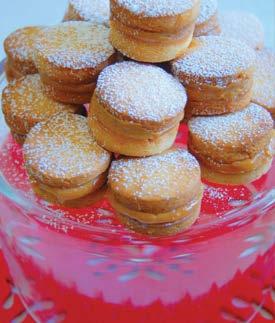
METHOD
1. Place the flour, icing sugar and cubes of butter in the bowl of a food processor and blitz until the mixture resembles coarse breadcrumbs. Add ½ teaspoon of the finely crushed star anise to the mixture and pulse briefly to combine. 2. Add the eggs and vanilla extract to the flour mixture and process until the mixture comes together in a ball. Turn the dough out onto a clean bench top and flatten the dough a little, then wrap in clingwrap and chill in the fridge for 1 hour. 3. Preheat oven to 180°C (fan-forced). Line a baking sheet with baking paper and set aside. 4. Lightly flour the bench top and roll out the pastry to 5mm thick. Cut 5cm rounds from the dough and place the disks on the baking sheet. Refrigerate for 30 minutes before putting them in the oven. 5. Bake for 15 minutes until the biscuits are lightly golden. Transfer to a cooling rack to cool completely. If you want to make these ahead of schedule, freeze the unfilled cooked biscuits in an airtight container for up to one month. 6. Carefully spoon a teaspoon or two of caramel onto the flat side of one biscuit, then sandwich with another biscuit.
Repeat with remaining biscuits. If you want to, dip the sides in a small bowl of finely chopped nuts so they stick to the caramel. Store in an airtight container for up to 5 days.











